Rose

The Ballad of Jack and Rose
improper feelings for one another.
There's a moment in the film in which she explains:
-If you die, then I'm going to die.
-If you die,there will have been no point to my liviing, he responds.
Lily
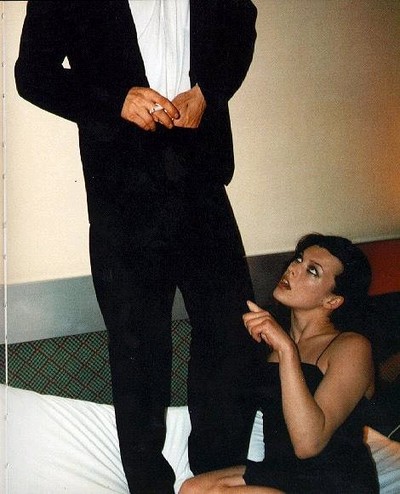
Admittedly, they did catch me off-guard when also carrying their magazines in my mother-tongue. Impressive. I decide for once to actually glimpse through this piece of offering, only to find a section called Young People Ask- Why don't girls like me? Tips targeted to ÿoung males include (apart from cultivating good manners and conversation skills and maintaining personal hygiene) always taking the initiative;
If you think a friend whom you admire might make a good marriage mate, let her know you are interested in her. Be clear and fortright in declaring your feelings. Yes, it can be nerve-racking. You fear rejection. But your being willing to take the initiative is a sign that you have grown up.
On what not to do the following is disclosed:
Don't flirt. A flirt uses flattering speech and provocative body language. He has no intention of pursuing an honorable romance relationship. Such actions and attitudes igonre the Bible's counsel to treat "younger women as sisters with all chastness". Flirts make poor friends and worse marriage mates. Discerning girls know that.
It would be highly ignorant to judge on the basis of just a small passage in what could almost be described as a pamphlet and especially knowing particularly little about their beliefs. There is however a part of me which is immediately thinking that the 18th Century likely will be calling requesting its values back, any time soon. Having recently finished work on the topic of whether Relgion creates gender roles I find the reading I was just subjected to, to be rather interesting.
Photo: Juergen Teller.
Lara

Klein's aesthetic is macabre and cinematic and this frame in particular will make you think of, say, the likes of David Lynch or David Cronenberg. The first thing that immediately comes to my mind viewing this is J.G Ballard's controversial 1973 novel Crash, which was mise en scène by Cronenberg in 1996, about people with the automotive paraphiilia of getting sexually aroused by causing and experiencing real car-crashes. With that in mind, I'd think the girl just may have deliberately crashed her speeding car against a wall, resulting in the death of the man and finally enjoying the aftermath with a little cigarette. Would this image have been less disturbing, were the roles reversed? I think for some the answer would quite likely be yes.
Brian
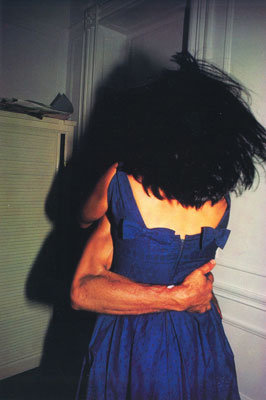
Nan Goldin -The Hug (1980) NYC
Roger
-Hallo...
-Hallo.
- Do you need help?
-Who doesn't?
-Is that your heart?
-Yeah.
-Big?
-It's small now.
-Small?
-It was bigger before.
-Scary.
-Yeah, that's my problem.
Barack


With Richardson to his left
Marlon
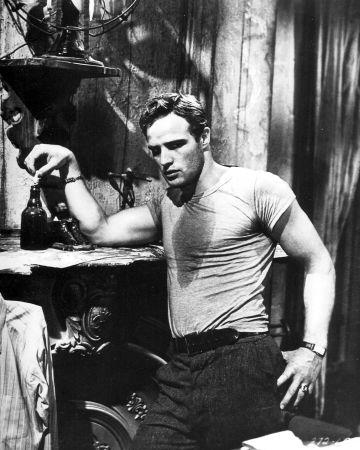
Marlon Brando in A Streetcar Named Desire
You realise quickly though that even occasionly hosting space for utter unimportances and random guilty pleasures can have legitmy as long as it's done under the pretense of something else or at least in a context that shifts focus into something just a little bit more mindful and worthwhile. As this is as self-conscious as I'll ever get, I might as well throw in doing something which will definitely be a one-off and remember it as a promise, why don't you?
Now, given what was just said, I do think that the t-shirt, casual as it is, can result in a very efforlessly smart and good look. Well, provided it is not too loosly or snuggly-fitting and is simple. Black or just white. Afterthought; maybe just black for some people. After all, there is one's complexion to think about... However, in regard to this piece of garment my take is not at all of any interest. No no, what I offer on the subject is of very little worth, please rest assured. Nevertheless, I rather find it interesting to learn what impact the film industry of the wicked west originally had on the boost of sales and popularity of the t-shirt.
Once nothing more than an utile cotton garment worn merely as an undershirt by the army troups in WWI (Apparently, less clear is whose army is to be credited for this introduction. Allegedly, the French Army, British Navy and the British Navy are all exclusively claiming) The film industry would later play a significant part in popularizing the t-shirt, creating a new trend by an original use of this garment that already existed in the wardrobe of every male but was never ever seen worn out on the streets (apart from on the back of construction workers on particularly hot days)
Most notably it was Marlon Brando wearing the t-shirt in Elia Kazan's classic A Streetcar Named Desire that would render this shift. The t-shirt he wore was a "sexualised reimagining" of the standard t-shirt at the time. Up until then t-shirts had no shape, no fit.With the film's costume designer Lucinda Ballard the t-shirt became more accentuating of the physique and revealing, as it was sewn in at the back for Brando. Impressively, Ballard's work on A Streetcar Named Desire earned her an Oscar for costume design. James Dean mimicking his idol Brando would later wear the t-shirt in Rebel Without a Cause and the two would subsequently become advocates of it for a new generation of men; as resorting to clichés will have me say.
Bob

Photography can appear so timeless, much like this edgy piece. Who would say this was more than 40 years old?
Photo: Bob Richardson
Anjelica
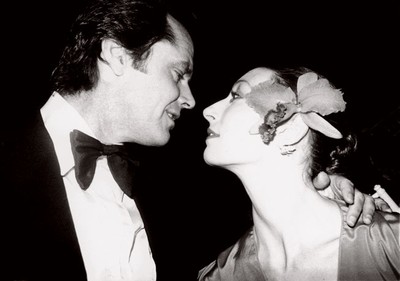
On the topic of love she so wisely offers: "There is really no justice in love. You can't go into something emotional with a bargain in mind. You have to love unequivocally. You have to be direct in your emotions otherwise you can't expect anyone to deal directly with you."
In an interview with Parade Magazine Jack said about impregnating another woman with a child, while still in a relationship with Huston and upon learning the news:
"I was in a quandry. I knew having a child was a boon to my life, but I was in a wonderful relationship with Anjelica. It was as good as it gets. I immediately told her what was up, and she made the decision for us. Anjelica's first response was, 'You have to support this woman' Her second response was to come down to my job and beat the hell out of me. She really beat me up, I tell you. Anjelica can punch!"

Jacques
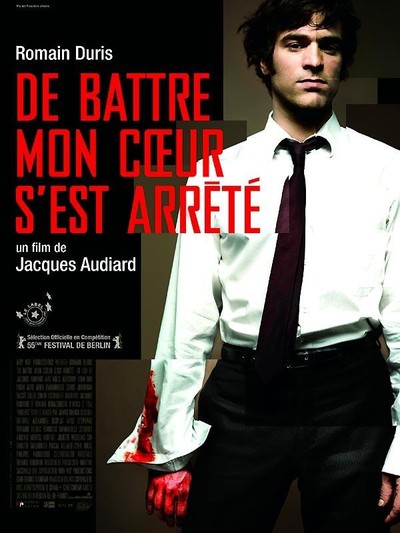
,.
De Battre Mon Coeur S'est Arrêté (The Beat My Heart Skipped). A gem from 3 years ago. Do I genuinely believe anyone would want to watch a film, simply judging by artwork like this? I sure as hell would hope so.
Helena


Jennifer Chambers Lynch' film Boxing Helena which she wrote at 19 (!) screened at the Sundance Film Festival in 1993 to massive expectations and was allegedly the most anticipated film of that year's section. Why would it not, with the film being the directorial debut of David Lynch' daughter? The latter had jumped on the stardom wagon with the ever so popular TV series Twin Peaks, launching him from the art house film theatres into the television sets of million of viewers worldwide. At the festival, Lynch Jr asked the public and press for her work to be separated from her fatther's and acknowledged in its very own right. Yet for her debut feature she used Sherilyn Fenn (known for her role as Audrey in Twin Peaks) in the title role of Helena and also used her father's cinematographer to lense it. So much for distancing, no?
The film faced its fair share of stirring controversy even before its release, mostly due to the actresses who quit the project deeming the role to be too risqué. Kim Basinger (likely not wanting to get typecasted after Adrianne Lynn's 9 1/2 Weeks) quit despite facing a law suit for the sum of $8 million for the breach of a verbal agreement which she was ordered to pay, resulting in her declaring personal bankruptcy. Even Madonna rejected the part at the height of her notorious Erotica-phase. Shouldn't this film then have served her well as an acting vehicle? Two hours after its screening, Boxing Helena died a merciless death, sending whatever hope Sherilyn Fenn had of a A-list future into despair. It was brutally savaged by critics, taking Lynch another 14 years making her second film.
I had almost forgotten about this film until seeing it again for the second time the other day. Understimated? No. It is however a prime example of one of those films that are so bad they actually almost become somwhat good. The storyline is very interesting, it has to be said, and with more competence involved in the making of the film it could have been a real contender so to speak. The execution is however far too poor for the film to offer any substance and instead it ends up looking like a B-rate steamy softcore adult film. Keeping things short, the story is of an obsessed surgeon who being unable to forget a former bitchy flame, imprisons her inside his home after an unforunate car accident that resulted in the amputation of her legs. Later he also amputates her arms, ultimately cutting her off from the world outside and making her dependent on him, to secure being the only one to ever love her. Yet another tale of the nautre of sexual obsession. When Woman in Chains by Tears for Fears starts playing as a backdrop in the film, it all just becomes a little too literal to not provide laughs.
The whole film can be streamed online through the following link:
http://www.megavideo.com/?v=0S3R0VJT
Agyness


Miranda
Shot on a mere budget of $150, above is Miranda July's short film titled Are You the Favourite Person of Anybody?.
And if you are; how sure are you? Very certain- Confident -Think so- Not so sure- Could be?
Starring: Miranda July and John C. Reilly.
Note: July is the author of the short story collection No One Belongs Here More Than You and director of Me and You and Everyone We Know.
Noah
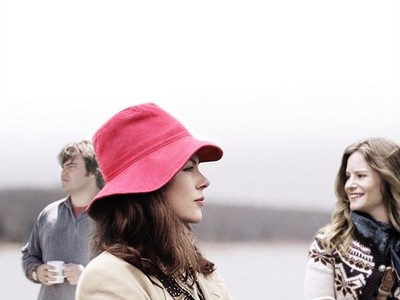
Noah Baumbach's Margot at the Wedding
The New Yorker (not to be confused with New York Magazine) is such an intelligent and high-profile publication,unmatched by others, that stands the test of time. The New Yorker has since long had a tradition of highlighting the best of modern fiction by featuring short stories by contemporary writers. To mention just a few it has seen the contributions of the likes of Zadie Smith, Philip Roth, Richard Yates, Haruki Murakami, J.D Salinger and John Cheever. It's website currently features an enormously hillarious story by talented director Noah Baumbach who helmed one of the best films of recent years, The Squid and the Whale and whose sophemore effort is the somewhat more flawed, yet interesting Margot at the Wedding.
It's called Buzzed and is about what goes on inside the head of a bee jacked up on cocaine.
Following fact from The Times is provided for the reader which served Baumbach as inspiration:
To learn more about the biochemistry of addiction, scientists in Australia dropped liquefied freebase cocaine on bees' backs, so it entered the circulatory system and brain. The scientists found that bees react much like humans do: cocaine alters their judgment, stimulates their behavior and makes them exaggeratedly enthusiastic about things that might not otherwise excite them.
An excerpt:
"My little feet on the petal. Is that odd? It seems so funny to me. Oh, my God, you gotta try this pollen. It's so fucking . . . it's better than the nectar, even. This is the best fucking pollen I've ever had. God, I so badly wanna just go sting the fuck out of someone, you know? Just land on their ass and sting. . . . I'm so fucking jazzed right now. And then I hope they're allergic and they just blow up! We gotta get out of this hive, we gotta get mobile . . . "Going Mobile"!
Read the rest on New Yorker.com
http://www.newyorker.com/humor/2009/05/04/090504sh_shouts_baumbach
Jefferson
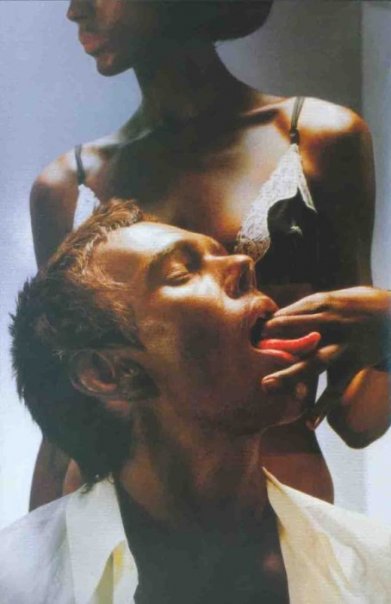
Now don't be a sourpuss.
The one single most useful advice you will likely be given is that the most important relationship you will ever have is the one you have with yourself.
Photo: Dazed & Confused, November 1998 Issue.
Sven

Sven Nykvist with Andreij Tarkovskij
There's a whole shebang of people to be credited for the effort of creating a feature film; there are producers, executive producers, screenwriters, editors, cinematographers and costume designers and pretty much a list that goes on from there. I admit to sometimes neglecting this fact when watching the Globes or the Academy Awards on television, wishing there was a fast-forward function to jump ahead, past awardings in categories such as Best Achievement in Sound Editing, straight 'til the far more suspensful and exciting moments of made-up-for-the-camera smiles for fellow contenders and larger than life speeches in the actor categories. Yet, it's wonderul that these more anonymous contributors of a film are publically acknowledged, by and in front of their peers in such grand-scale at the most prestigious of functions imaginable.
Gone are the olden days when studio executives and producers such as the likes of Jack L Warner, Samuel Goldwyn and David O Selznick would end up with most of the credit for a film. Today, partly due to the effort made by the auteurs (directors) of the French Nouvelle Vague (Francois Truffaut, Jean-Luc Godard, Claude Chabrol, Alain Resnais et alia) in reclaiming this aforementioned credit, focus is to a much greater extent on the film director who serves as a creative leader, executing his entire vision into what is seen on the screen and thus making the magic happen. As such, late director Ingmar Bergman was a visionnaire of his very own kind, often ahead of his time in terms of the depth displayed in themes and writing.
One of the great achievments of Bergman's films lies in their quality of being a visual treat for the eye. For this, much credit is due Bergman's cinematographer and friend Sven Nykvist who had an unique sense of natural lighting, using it masterfully to create ambience and enchancing sentiments of characters. He remains one of the most succesful cinematographers in film history and is a part of very small group of cinematographers who have been able to make a true mark for themselves that stretches far beyond the admiration of just the industry. Other notables include cinematographers Lazlo Kovacs (who worked on the American New Wave) and Wong Kar Wai's recurring team member, Christopher Doyle.
Nykvist achieved not only one but two Academy Awards for his work in Bergman's Cries and Whispers and Fanny & Alexander. Notably he also worked with other maîtres of the cinema such as Woody Allen, Michelangelo Antonioni and Andreij Tarkovskij.
Sven Nykvist with Woody Allen
Bryan


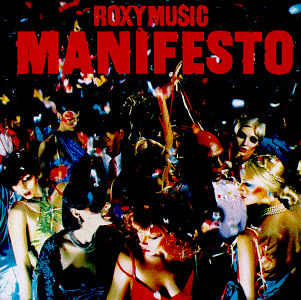
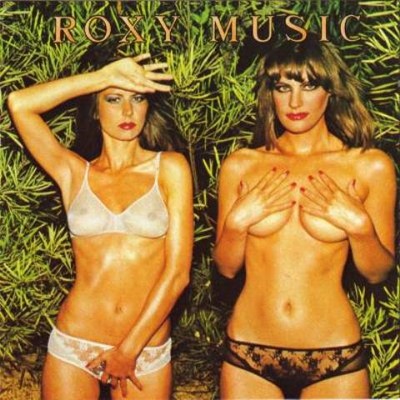
Stan

While researching for a list of married superheroes, I instead found a list of superheroes who are not able to have sex and consequently cannot reproduce. It makes sense, there should be quite some. More interesting than so though was the discovery of the the first openly homosexual (and married) superhero pair in print; Apollo and the Midnighter from superhero team The Authority (published by DC Comics. Publisher of Superman and Batman) Like that wasn't interesting, it turns out the pair legally adopted a little girl, Jenny Quantum, from Singapore shortly after marrying. Neat to see that comic books can be so progressive. However, I wonder if some concerned parental organizations stateside are not having a field day over this, declaring a fatwa against such "immoral behaviour"?


The Midnighter and Apollo
Raquel

artwork for the Stainless Steel album sleeve
Rhys says about the debut effort of the band:
"The Neon Neon album is a full-on concept record about the wives and lives ... Of John DeLorean, so it's been a real pleasure to write about a specific subject, and to think about various scenarios relating to his life and imaginary scenarios that may have happened to him on the way. And so musically we've been writing in a style that personally mirrored his kind of fast, cocktail-driven lifestyle. ... It's a very frivolous electro-pop record about the first playboy engineer."
You have to admire the dedication that goes into working with a truly conceptual project. Neon Neon's song Raquel (based on Raquel Welch) has been playing at this residency all day long. I guess we've reached the era in time where one basically just urges others to listen to track so-and-so on the application that is Spotify. For all it's worth, check Raquel out.
Although about Ms Welch, it's twice as fun picturing a snazzy Raquel Zimmermann during plays of the track.

Isabel

Map of the sounds of Tokyo
If the title alone; Map of the sounds of Tokyo, is not enough to make you curious to see this film, then the mere name of helming director Isabel Coixet should. Spanish born Coixet could be descried as Susanne Bier's long-lost twin sister from another mother. Having already directed the thoroughly beautiful My Life Without Me, The Secret Life of Words and Elegy (based on The Dying Animal, a short story by Philip Roth) she is as we speak featured in this year's competiition section for the Palme d'Or at the Cannes Festival. The backdrop of Tokyo and main actors Sergi López (Une Liasion Pornographique, Harry, he's here to help) and Babel's Rinko Kikuchi should help this feature turn out as worthwhile as Coixet's previous work.
The official synopsis reads:
Ryu is a solitary girl whose fragile appearance is in stark contrast with the double life she leads, working nights at a Tokyo fishmarket and sporadically taking on jobs as a hit-woman.
Mr Nagara is a powerful impresario mourning the loss of his daughter Midori, who has committed suicide. He blames David, a Spaniard who runs a wine business in Tokyo.
Mr Nagara's employee, Ishida, was silently in love with Midori and hires Ryu to murder David.
A sound engineer, obsessed with the sounds of the Japanese city and fascinated with Ryu, witnesses this love story which searches the shadows of the human soul, reaching deep into places where only silence has the power of eloquence
It's strongly suggested for whoever is interested to check out the trailer on the film's official website. It looks worth the wait.
www.mapofthesoundsoftokyo.com
Julian

Thank you for having made indie the poor man's __________(Insertion of whatever is the ultra new black). I think I prefered you guys more a handful years ago when you still thought (F)eminem, Linkin' Park and Blink 182 were the coolest thing ever since sliced bread. You remember? Well, just letting you know we've really given up so you can keep whatever you want. Just keep it all, do whatever you want with it. Not that you ever awaited a blessing but fuck that, let's not any more of this. Just, please, keep hands off Frida Hyvönen and Jenny Wilson and will all get along just fine. Otherwise something will go down.
Open letter to non-dancers,
All of us who actually manage to move gracefully, controlled, while excuding shitloads of confidence and not coming across as looking akward or dorky and moving like from another era in time that never existed, actually have so much more fun the the rest of you. I host sympathy though, clearly remembering times when dancing was stepping with feet from right to left and back. Whatever I know, I learnt from stealing and picking up moves from friends throught the years. Not trying at all, just makes no sense to me whatsoever. Surely you do realise yourselves what you miss out on?
Kirk

Jane, Henry and Peter Fonda
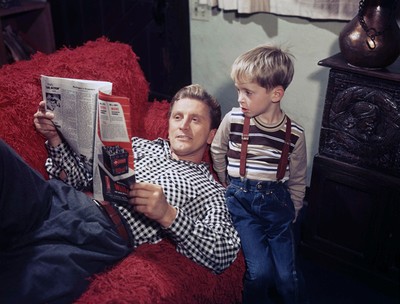
Kirk & Michael Douglas
Ode to the family album.
Vintage imagery of two generations of actors; the Fondas and the Douglas. It's hard not to love the facial expressions displayed in the first frame and the candidness of the second one.
Who knew these kids would grow up to play such iconic characters as Barbarella, Captain America in Easy Rider and Gordon Gecko in Wall Street?
Alfred

Dial M for Murder (Charlize Theron)

Rear Window (Scarlett Johansson & Javier Bardem)
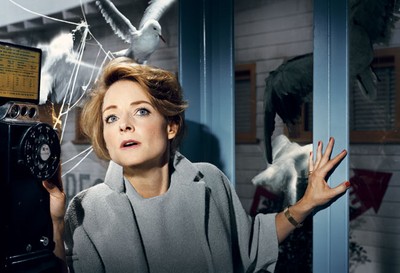
The Birds (Jodie Foster)
Everyone's a goddam photographer today they think. An expensive digital camera and some basics in Photoshop and you're a self-made photographer. A snap at a picturesque scenery and that's it. It's all too easy to get a beautiful looking shot today, why true talent is seen only in a frame with a clear vision behind it, however simple and natural the frame itself may be. Lucky shots, just don't really count, at least not to me. When viewing an image I want to be convinced it was a very deliberate and conscious effort on the photographer's behalf; that this particular moment of a person gazing at the sun caught the interest of the photographer. Natural photography i.e. unstaged imagery that is not set-up, requires a perfect and sharp eye (in regard to potential subjects) to actually produce a really interesting image. Few people have that or at least fewer than those who don't.
Alfons
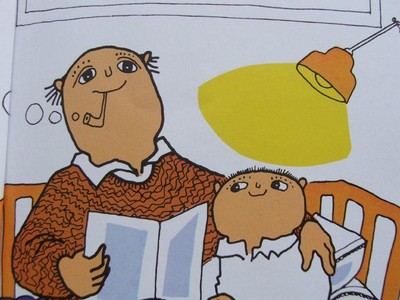
Alfons Åberg was raised single-handedly by his father in what seems as a loving environment. Sure, he got into a fight once and had an imaginary friend called Målgan but he turned out quite alright. Some even say he grew up to become the Prime Minister of Sweden, Fredrik Reinfeldt.
Sasha

Says Grey about how she is viewed: "A lot of people don't want an intellectual porn star. They don't want a porn star to be a performance artist or a musician or a photographer. They just want the clichéd idea of porn star." Indeed there is a certain nature in people that is unwilling to accept and allow subsequent changes in people and viewing others outside of the box that is whatever role is imposed on them by society. Who wouldn't honestly react to a person out of the "ghetto" reading Sartre and playing the chello with a little enchanting "Oh..." in their mind? I can think of a few, actually many.
It's interesting how Gray speaks of feeling empowered as a woman in porn which is obviously diffuclt for normals to grasp, of which she seems perfectly aware; "Some people believe in God and the devil and some people do not believe in anything. Some people like porn and sex, and other people believe in monogamy. What one person sees as degrading and disgusting and bad for women might make some women feel empowered and beautiful and strong."
Again, regarding points of view there are seldomly "objectively rights", only "more-commons" and "less-commons".
Merrill
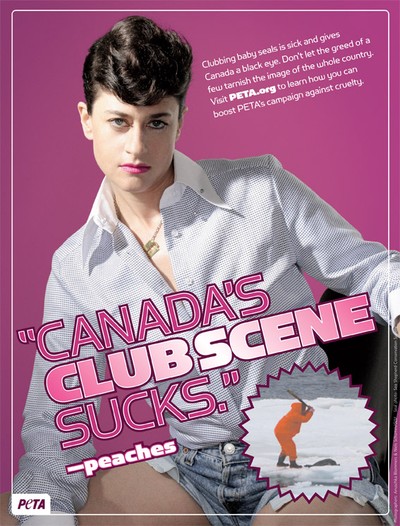
This is what PETA's (People for Ethical Treatment of Animals) ad campain featuring ultra-hip musician, Peaches, (Impeach My Bush, Fatherfucker) reads. I quite like the word play of "club scene" here and some of the effort that PETA are making in general in rasing awareness about animal cruelty. I used to belong to this certain law-related organization in which one of the most treasured anthems was about clubbing seals consisting of a cruel discription of how going about. Absolutely hideous it was. I only ever sang it once. People didn't quite seem to get enough of it though. Sheep.
On another note there is PETA's main target in their activism: campaigning against the use of fur.Targeted is often US Vogue's influential editor in chief, Anna Wintour, for using animal fur in her magazine for years now. At a recent public interview she was met by PETA members in the audience who chanted: "This woman skins animals alive!" Wintour's immediate facial expression to the stunt has been described as "a mix of polite restraint and Is there no security in this place?
Without taking a stand against or for use of fur, I guess it's reasonable to at least expect animals to be treated without cruelty when obtaining the fur.
Jacques

Picture by The Sartorialist for his website (On the street...Slussen Subway Stop, Stockholm. Thursday, August 16, 2007)
Currently writing on a short paper for my Law and Gender class, I found the following circumstances in France to be particularly interesting.
In France a prohibition against wearing a veil and other visibly (discrete ones are still permitted) demonstrative religious symbols at state schools was established through legislation by the Parliament in March 15 2004 after an intense debate in the media with numerous groups voicing an opinion. A noted case that would to start the debate in France originates from 15 years earlier back in 1989 when 3 teenage girls were expelled from an elementary school in the city of Creil for wearing the veil. Disobedience against the law may result in repercussions against a student and has since in force resulted in the expulsion of 50 students (including 3 boys for wearing turbans)
Those in doubt of the legislation have in the French debate been met as anti-Feminist and anti-freedomist. On one level there's a blatant contradiction in a state passing legislation in the name of the freedom of some when this legislation goes against the freedom of choice of the targeted group. Many of the girls wearing veil today are doing so by very own will and in their case the law ends up defining for them its own concept of freedom.
The nature of the use of the veil is far more complex and nuanced than always acknowledged. Through the perspective of some of these girls the veil, contrary to being oppression, rather marks a sort of self-empowerment in terms of having the freedom over their own body and being in charge of how it may be viewed by others. Only in cases, because there are certainly those as well, where the veil is imposed on women does it come across as reasonable for anyone to even speak along the lines of "oppression". The legislation however puts all veil wearing girls in the same category in its quest to "free" them. Critics of the veil will conclude that despite appearing as by free will for some, these girls de facto lack a choice of their own as what is "the right thing to do" as a Muslim with which they want to comply, is originally being directed to them by others i.e. male interpreters of the Quran. Likely some girls, who are subject to the legislation, do act out of expectations of their family and thus passive pressure.
Yet, even that being the case, what right does the law have here being opiniated about how people conform to their religious beliefs?
Judith

One of the major mistakes people make is that they think manners are only the expression of happy ideas. There's a whole range of behavior that can be expressed in a mannerly way. That's what civilization is all about - doing it in a mannerly and not an antagonistic way. One of the places we went wrong was the naturalistic Rousseauean movement of the Sixties in which people said, "Why can't you just say what's on your mind?" In civilization there have to be some restraints. If we followed every impulse, we'd be killing one another.
Photo: Charlotte Rampling and Juergen Teller in a frame shot by Teller.
Mia
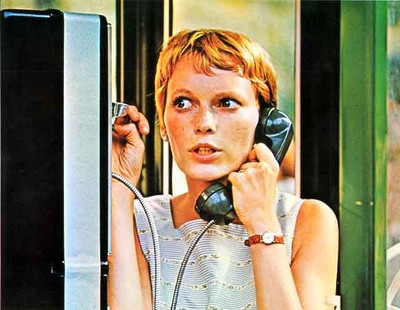
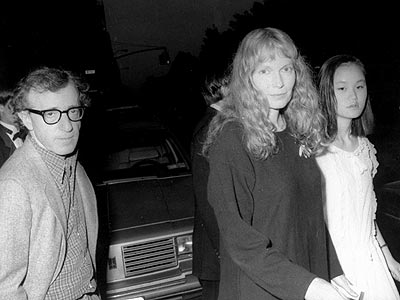
Woody Allen, Mia Farrow and Sun-Yi Previn
Patrick
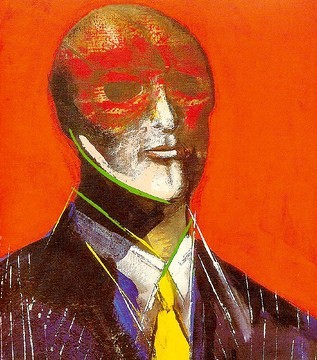
"A half hour later I am hard again. I stand up and walk over to the armoire, where, next to the nail gun, rests a sharpened coat hanger, a rusty butter knife, matches from the Gotham Bar and Grill and a half-smoked cigar; and turning around, naked, my erection jutting out in front of me, I hold these items out and explain to the girls in a hoarse whisper, "We're not through yet. . . ." (excerpt from Bret Easton Ellis' novel American Psycho)
I found this anti-Ellis website of which the creators had the following to say about Ellis and his novel:
"Our message to Bret Easton Ellis is this-- We do not find your racist, sexist, homophobic fantasies (or are they really more than just fantasies?) "playful", "satirical", or entertaining. Indeed we are outraged that a book describing such graphic sexual violence, such blatant misogyny, such outright racism and homophobia, has been accepted by mainstream America (it was on the NY Times paperback bestseller list in April). Have we allowed the mind-numbing bombardment of the media to desensitize us to such an extent that we have an unlimited tolerance for violence? When will this woman-hating end?"
James

Let me hold you
For the last time
It's the last chance to feel again
But you broke me
Now I can't feel anything
When I love you
It's so untrue
I can't even convince myself
When I'm speaking
It's the voice of someone else
You can't play on broken strings
You can't feel anything
That your heart don't want to feel
I can't tell you something that ain't real
Oh the truth hurts
A lie is worse
I can't like it anymore
And I love you a little less than before.
Oh what are we doing
We are turning into dust
Playing house in the ruins of us.
James Morrisson feat Nelly Furtado- Broken Strings
Photo: Unkown.(Portrayed) Nicolas Duvauchelle & Ludivine Sagnier
Brian

Here we are
Stuck by this river,
You and I
Underneath a sky that's ever falling down, down, down
Ever falling down.
Through the day
As if on an ocean
Waiting here,
Always failing to remember why we came, came, came:
I wonder why we came.
You talk to me
as if from a distance
And I reply
With impressions chosen from another time, time, time,
From another time.
Photo: Director Theo Angepoulous' film Trilogy: The Weaping Meadow
Kurt

Featured below is what is allegedly Kobain's suicde note in which he mentions both daughter Frances Bean and musician wife Courtney Love (Bless her, really. I don't care if she remains a crack hag the rest of her life, she may be whack but will always be Courtney)
Speaking from the tongue of an experienced simpleton who obviously would rather be an emasculated, infantile complain-ee. This note should be pretty easy to understand.
All the warnings from the punk rock 101 courses over the years, since my first introduction to the, shall we say, ethics involved with independence and the embracement of your community has proven to be very true. I haven't felt the excitement of listening to as well as creating music along with reading and writing for too many years now. I feel guilty beyond words about these things.
For example when we're back stage and the lights go out and the manic roar of the crowds begins., it doesn't affect me the way in which it did for Freddie Mercury, who seemed to love, relish in the the love and adoration from the crowd which is something I totally admire and envy. The fact is, I can't fool you, any one of you. It simply isn't fair to you or me. The worst crime I can think of would be to rip people off by faking it and pretending as if I'm having 100% fun. Sometimes I feel as if I should have a punch-in time clock before I walk out on stage. I've tried everything within my power to appreciate it (and I do,God, believe me I do, but it's not enough). I appreciate the fact that I and we have affected and entertained a lot of people. It must be one of those narcissists who only appreciate things when they're gone. I'm too sensitive. I need to be slightly numb in order to regain the enthusiasms I once had as a child.
On our last 3 tours, I've had a much better appreciation for all the people I've known personally, and as fans of our music, but I still can't get over the frustration, the guilt and empathy I have for everyone. There's good in all of us and I think I simply love people too much, so much that it makes me feel too fucking sad. The sad little, sensitive, unappreciative, Pisces, Jesus man. Why don't you just enjoy it? I don't know!
I have a goddess of a wife who sweats ambition and empathy and a daughter who reminds me too much of what I used to be, full of love and joy, kissing every person she meets because everyone is good and will do her no harm. And that terrifies me to the point to where I can barely function. I can't stand the thought of Frances becoming the miserable, self-destructive, death rocker that I've become.
I have it good, very good, and I'm grateful, but since the age of seven, I've become hateful towards all humans in general. Only because it seems so easy for people to get along that have empathy. Only because I love and feel sorry for people too much I guess.
Thank you all from the pit of my burning, nauseous stomach for your letters and concern during the past years. I'm too much of an erratic, moody baby! I don't have the passion anymore, and so remember, it's better to burn out than to fade away.
Peace, love, empathy.
Kurt Cobain
Frances and Courtney, I'll be at your altar.
Please keep going Courtney :)
for Frances.
For her life, which will be so much happier without me.
I LOVE YOU, I LOVE YOU"
Jesper

The Kolla! exhibition is currently being displayed at Allmänna Galleriet in Stockholm (Kronobergsgatan 37, Kungsholmen) with contributions from the Kolla! competition which awards artists in main categories such as: Graphic design, Illustration and Moving images.
Above is Swedish illustration guru Jesper Waldersten's (Här kommer jag, Tack för senast din djävul) contribution entitled Viktor & Rolf that was runner's up in the sub category Editorial Illustration. From the same sub category, below, is Graham Samuel's Romanov Must Die. The exhibition is ongoing until May 16.
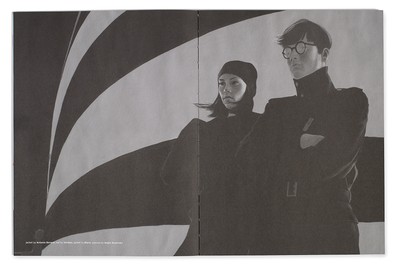
Mario
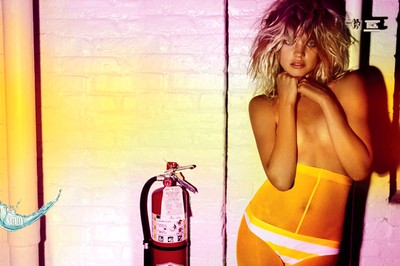

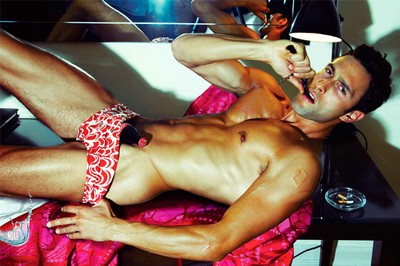
Just a reminder of summer being around the corner; Mario Testino shooting the swimsuit issue for V Magazine. It's a good piece whatwith all the tastefully colourful pages in mind. Enjoy all, whichever or none, whatever rocks your boat.
Frances
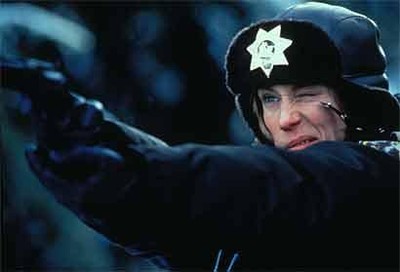
When her future hub Ethan Coen (of the Coen brothers) asked her on their first date about what she looked for in a man, Frances McDormand simply answered: A worthy adversary.
How fantastic is that?
Brad

Generally birth rates are declining in Europe, with the Nordic countries presently having the highest ones, save for France. Eastern European countries come at the bottom (together with Italy) and have birth rates that are considerably lower than in the Nordic countries and have been low now for over a decade by now. The balance between the birth rate and the death rate is determing in terms of the natural population growth of a country (immigration plays a part as well in the growth while emigration may under normal circumstance be negligible) While the overall population of the world is increasing, the UN states that Eastern European countries (for instance: Bulgaria, Latvia, Russia, and Ukraine) are likely to lose between one third to half of their population by the middle of this century.
When examining the decreasing of birth rates in some parts of the world it's interesting to have a look at what de facto need there is of children today. Way back when for example in a rural society families had to produce everything they needed in their living themselves. Women took care of the household, raising the children and taking care of the production of food and men went out to work to earn money and took care of the heavier chores. In a society where most of what you consumed had to be produced by yourself, the family had a greater significance than today. The more children the family had the more people there were helping out with the chores. A perceived importance of passing on the family genes through male figures of the family may also explain a higher birth rate than what is the case today in many parts of the world. Families might have given birth to numerous children in order to have a couple of sons. Sons were looked upon as needed to take care of parents when they grew older as daughters left home after marriage.
In another time, giving birth to biological children might have been unquestioned and seen as a natural and very integrated part of life, due for everyone. The concept of the family is more vague today and doesn't necessarily include man, wife and children as it has tradition-wise. There are alternative forms of living that don't necessarily fit with bringing up children. Also a pro-choice attitude is generally more common today. Abortions have become more available in places where it previously was not as accepted as for example in Eastern Europe.
Importantly there is also a significant link between aiding women in combining work life and family life and the birth rate. The aid in question include factors like equality between men and women in raising the children i.e. father's participation, possibilities for parental leave post-birth and and especially paternal leave, social welfare and the existence of state subsidized day care. If men are taking leave after the birth of a child, the women can return to work for part of that time. With state subsidized day care women can go back to working full time within reasonable amount of time and families can go on having two full incomes, why having children doesn't have to be an economic blow. It's said that only countries where women are provided good possibilites of combining work and family life, will see sustainable birth rates.
A large decline in birth rates in Eastern Europe could at least partly be explained by a relatively sudden change of more women so to speak leaving their homes to enter the labour force without having the same aid of Nordic women. Women in Eastern European countries are also becoming more educated on higher levels and as a rule the better educated women are the fewer children they bear. Higher level studies for these women also mean they will have children later in life which has impact on the number of children they will give birth to. On the one hand Nordic women are obviously
well-educated too but on the other hand they've generally also so far had better possibilities of both being working women as well as mothers.
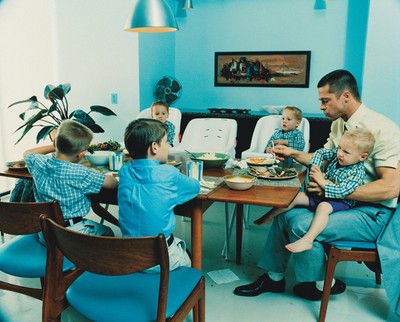
Photo: Steven Klein shooting Jolie and Pitt. The pair adopted 3 children and gave birth to 3 biological ones (not pictured here)
Patti
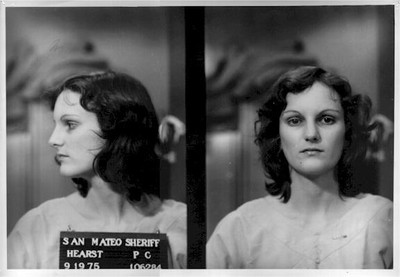
Remember the excessive medial coverage of a certain heiress being sent to jail for a few weeks the other year for a DUI (Drinking Under the Influence)? Well, the unfortunate fate of Ms Hotel Heiress fades in comparisation with that of heiress Patti Hearst. It's not difficult to picture that the Hearst saga must have created some serious headlines in the press and media waves worldwide in the 70's, of when it's dated.
Patti Hearst is the mother of model Lydia Hearst and heiress of newspaper publishing giant William Randolph Hearst (on whom the character of Charles Foster Kane in Orson Wells' Citizen Kane was supposedly based) and was in 1974 at the age of 19 captivated by gunpoint from her appartment for ransom money by members of the Symbionese Liberation Army (SLA). The SLA was a left-wing urban guerilla group that committed bank robberies and various acts of violence. The SLA orginially conditioned Hearst's realease by the release of jailed members of the group but later demanded the Hearst family to make a donation of $70 million worth of food to needy Californians. A small portion of the demand was met by the family which did not result in a subsequent release.
Later Patti Hearst announced on audiotape that she was no victim and had joined her captors in their aim "of freedom of all opressed people" and would be assuming the pseudonym "Tania". Patti Hearst a.k.a Tania participated in a robbery of a branch of the Hibernia Bank (founded by the family of her close friend Patricia Tobin) which wounded two people who were shot. The videotape from the surveillance system saw Hearst entering the bank with other members of the SLA holding a rifle and yelling: "I'm Tania. Up against the wall, motherfuckers!". The group fled only a few minutes later.
At one point the police surrounded a house where many of the SLA members were residing which led to a shoot-out ending in six of the members getting killed and the house burning down in flames (which could be seen live on TV) Hearst was arrested by the FBI 18 months after her kidnapping and when asked about her occupation she stated "Urban guerilla". Adding to an already sensational story and cashing-in on the insatiability of its readers TIME magazine even manipulated her mugshot before publishing it, making it look like Hearst had been beaten and was drugged at the time of her being caught. Her trial was called "the trial of the century" and she was sent to prison on the charges of armed bank robbery and use of a firearm while committing a felony.
After serving two years of jail time her sentence was commuted by President Jimmy Carter. Heart claimed she had been brainwashed by the group and also been victimized by rape and abuse. Hearst however initially refused to provide evidence against members of the SLA.. In his last official act of office President Bill Clinton granted Hearst a full pardon.

Angela

Carole Bouquet and Angela Molina
As a concept this is quite risqué and demanding on the viewer's part in terms of suspension of disbelief but mostly on any two actors taking on such a task as it will require for the character to still feel consist and will put pressure on both about their performances being no less than equal so that there is no outshining the other. Nonetheless, it would be fairly interesting to see more of these sort of dual performances on screen but there will likely not be much of that, at least not within mainstream cinema.
Bunuels' films are about respectable middle-class people trying to deal with giving in to their inner desires. In Cet obscur object du désir Rey's Mathieu falls in love and obsesses over much younger Conchita, trying to court and win her over but continously gets his love for her denied. Ultimately the film tells of man's human nature of desiring what cannot be obtained. The film begins randomly with Mathieu audaciously pooring a bucket of water from a train, over Conchita's head while she is trying to board the train, to the great curiousity of fellow passengers. From there the film continues with Mathieu in flasbacks giving an account of their story and what has led him to this little act that just played out.
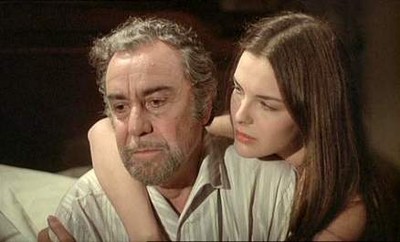
Leon
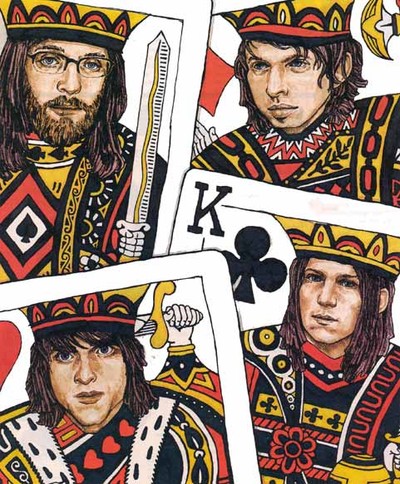
Oh and while at it, did I just miss the part where the Killers, seen in a tiny tent in 2004 with an audience of thirty people, went on to become a household name?
Max

Whether you'd want to remember him as the knight playing chess with Death in Ingmar Bergman's Seventh Seal or for any of his other great performances in the work of the late dirctor, as Father Lankester Merrin in The Exorcist , Karl Oskar in The Emigrants or like myself as Frederick in Woody Allen's Hannah and Her Sisters, Max Von Sydow remains one of the most succesful actors to emerge from Sweden. It's pleasing that even after reaching his eighties he is getting offered roles of substance. He was recently seen in Julian Schnabel's The Diving Bell and the Butterfly and will also appear in Martin Scorsese's upcoming film, Shutter Island alongside a long list of other illuminaries. Max von Sydow's having said he will continue making films as long as he is provided with worthwhile material, genuinely makes me hope producers of this world take good note. The man did age with plenty of grace, c'est clair.
He delivered some memorably witty lines in Hannah and Her Sisters:
You missed a very dull TV show on Auschwitz. More gruesome film clips, and more puzzled intellectuals declaring their mystification over the systematic murder of millions. The reason they can never answer the question "How could it possibly happen?" is that it's the wrong question. Given what people are, the question is "Why doesn't it happen more often?"
Mumrik

Tove Jansson's Snufkin or Nuuskamuikkunen as he is known in Finland is royally an appealing cat. He is effortlessly _______ .
Maurizio

Maurizio Cattelan is an contemporary Italian artist most kown for his controversial, yet humorous, art piece La Nona Ora (The Ninth Hour) depicting a scuplture of the Pope John Paul II being hit down by a meteorite from the sky. Other sculptures of his include, Par Peur de l'Amour (By Fear of Love), a sculpture of an elephant in a Ku Klux Klan uniform.
Cattelan is also known as a parasiting artist, who will use other people to execute his basic ideas and work. Cattelan himself will claim not to do too much during the process of an art piece and says about his effort: "It only takes a minute to have the idea." Cattelan's disinterest in journalists has also led to his on occasion sending other people to give interviews in his name claiming to be him.
Cattelan is also the co-creator of Permanent Food which could be described as a sort of meta-magazine consisting of pages of other magzines from all around the world (sometimes taken without permission and collected by a various number of people) resulting in a scrapbook feeling publication. It is a non-profitable project executed without offices by Cattelan and editing partner Domnique Gonzales-Forester. Additionly there is now also Permament Family, described as a photo album about photo albums with contributions made from family photo albums from near and far.
Recently I was lucky to catch one of Cattelan's installations with a friend while in Brussels at the contemporary Bozar (word play of Beaux arts) musuem. Not wanting to get infected by the descriptive words of the curator, I'm still trying to figure out what Cattelan's intentions were.
On his line of work Cattelan says: "Hunting for freedom, I've found the real prison. but at least it's a prison I've chosen for myself."
Tom
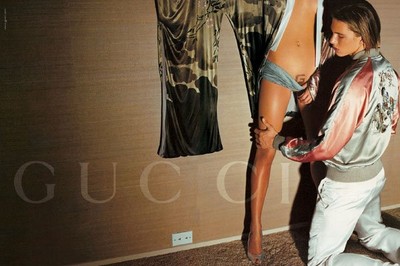
Is this ad sexist, mindlessly self-indulgent, degrading and objectifying? Is it just fun, original, clever and bold? How about, empowering for women? If this is an act of what it looks like, then who seems to be on the receiving end? Like is often the case with art, if you will, it all just depends on from which point of view one wishes to regard it. There are often several more reasonable perspectives than just one, although not always obvious for all.
While Testino shot this ad, it is still Terry Richardsson who shoots ads like these routinely.
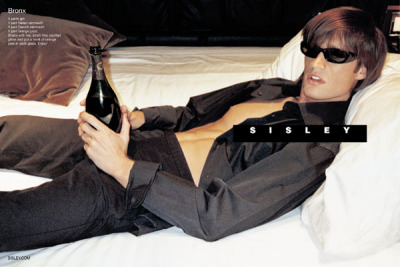
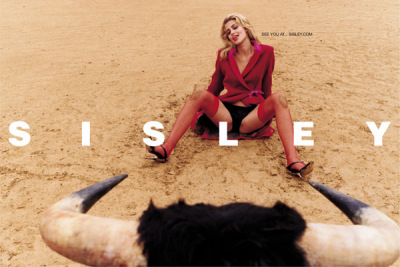
Sylvia

Their story leads to tragic twists of fate, ending in a number of suicdes beginning with Plath taking her own life at the age of 30 by placing her head in the oven with the gas turned on. There were cases of infidelity during their marriage on Hughes' part and Plath was left by him without divorce, for another woman by the name of Assia Wevill. Hughes later claimed the spouses never really considered divorce and that they were talking about reconciliation, only days prior to Plath's death.
Many of Plath's followers continiuously and aggresively blamed Hughes for her death. Only in his great poetic work, Birthday Letters, which was published 35 years after her death did Hughes actually address the issue of their relationship in his own words. Hughes eventually left Assia Wevill, who committed suicide (6 years after Plath's death) and murdered her 4-year old daughter by Hughes in the very same way Plath had died before her.
In March 2009, Hughes' and Plath's son Nicholas Hughes also ended his life with suicide at the age of 47.
Featured below is my very favourite poem by Plath.
April 18
the slime of all my yesterdays
rots in the hollow of my skull
and if my stomach would contract
because of some explicable phenomenon
such as pregnancy or constipation
I would not remember you
or that because of sleep
infrequent as a moon of greencheese
that because of food
nourishing as violet leaves
that because of these
and in a few fatal yards of grass
in a few spaces of sky and treetops
a future was lost yesterday
as easily and irretrievably
as a tennis ball at twilight.
(Note: The story of the relationship between Plath and Hughes was made into a film in 2003 starring Gwyneth Paltrow and Daniel Craig and is very recommended.)
Nina


Shaznay

Night swimming, beach walking
Always silent, never talking
Then you call my name
And I know inside I love you
Sail away, I miss you more
Until you see the shore
There I will be waiting
Anticipating
Each moment is new
Freeze the moment
Each moment is cool
Freeze the moment
I wouldn't wanna be
Anywhere else but here
I wouldn't wanna change
Anything at all (anything oh I)
I wouldn't wanna take
Everything out on you
Though I know I do (although I know I do)
Every time I fall
All Saints- Black coffee
Photo: From Julio Medem's gorgeous film Lovers of the Arctic Circle
Greta

Greta Garbo (formerly Gustafsson)
Speaking about stories it has to be Ingrid Bergman's words about her few meetings with Greta Garbo that are the most priceless. When Bergman left for the US, Garbo was already the number one silent film star who would eventually make the gruesome transition from silent films to sound films, only to become even more succesful than before with films like Camille and Ninotchka. Despite Bergman's trying to reach out to Garbo, the latter always kept her distance. Seemingly these two women were very different.
There was always myth around Garbo, only because she wanted it that way, even revelling in it and in many ways she was in control of her public persona. While her relationship with director Maurtiz Stiller (her mentor who notably directed her in the classic silent film adaptation of Selma Lagerlöf's Gösta Berlings saga) together with whom she left acting in Sweden for the US, is widely known, it has also been much talked about whether this Gretel preferred herself a Hansel or Hannie. At least some biographies will you have you believe Garbo spent parts of her life with female partners. Garbo was never a public figure and kept private. She experienced plenty of personal tragedy and loss and as a consequnce she had issues with trust and always feared losing what was hers.
Being clever enough to foresee that the end of WWII would surely see a change in the themes of films, changing to comedy and more up-beat stories, she withdrew from the business knowing she had to quit on top of her game (Garbo never saw herself as a comedienne). Despite popular beliefs, Garbo did not spend a very secluded life the first decades following her retirement and instead carried on a life in luxury, spending her time with royalties, socialites and very importants, though always off the public eye.
Here is an excerpt in Swedish about Garbo from Ingrid Bergman's biography:
"Hon var den vackraste kvinnan av alla och jag tycker alla hennes prestationer var enastående. Men Garbo ville aldrig träffa mig- hon kanske trodde att jag kommit dit för att tävla med henne. När jag förstod kom till Hollywood, sa Petter (Ingrid Bergmans första make, tandläkaren Petter Lindström) att jag som en liten gest borde skicka henne en blombukett, och det gjorde jag. Jag fick ett telegram tillbaka där det stod att hon skulle vilja träffa mig när jag var ledig. Hon bad om mitt telefonnummer. Jag var där i tre månader och jag skickade blommorna första veckan jag var där, men telegrammet kom bara några dagar innan jag skulle resa hem.
Jag minns att jag berättade detta för George Cukor vid ett senare tillfälle för George och Greta var mycket goda vänner. Jag sa att jag tyckte att det var tråkigt att vi aldrig hade träffats och att det varit så snällt av henne att skicka mig telegrammet men att det förstås hade varit sent. George skrattade och sa "Men Greta skulle förstås inte ha skickat telegrammet om hon inte vetat att du just skulle resa".
Jag såg också Greta när jag kom till Metros (Metro-Goldwyn-Mayer) för att spela in min fjärde film i Hollywood, Doktor Jekyll och Mr Hyde...Den första morgonen kom förstås både jag och Gabro ut ur våga loger precis klockan nio- vi var ju punktliga svenskor! Och så steg vi in i våra bilar, bara någon meter ifrån varandra. Men hon låtsades inte alls om mig och jag beslöt mig för att jag nog inte borde le och hälsa heller och insåg att hon nog besvärades av mig.
...
Många år senare var jag på en stor lunch på Barbados med min man Lars Schmidt, och in kom en grupp med Greta Garbo. Vad skulle jag nu göra? Skulle det bli ännu ett kyligt möte? Jag gick långt ner i den stora trädgården där folk satt och pratade. Lars och våra andra vänner talade med henne och hon måste ha frågat om jag var där, för jag såg att hon tittade åt mitt håll, och sedan kom hon också ner i trädgården och satte sig bredvid mig. Jag visste inte vad jag skulle säga, så nervös var jag. Men hon började tala och sa:
-Jag har hört att ni älskar Barbados och tänker köpa mark här ute?
- Ja, vi älskar den lilla stranden en bit härifrån och vi tänker bygga ett litet hus.
-Jaså, sa hon. Det skulle aldrig jag göra för de stjäl allting.
-Men det ska inte bli något luxuöst hus, bara en liten bungalow med rustika möbler, inte antikviteter eller något sådant, och vi ska bara använda den ett par månader på året och hyra ut den resten av året...
- Men de stjäl ens kläder.
-Kläder? Men allt man tar med sig till Barbados är ju baddräkt, ett par shorts och ett par långbyxor. Vill de ha dem får de gärna ta dem...
Hon sa ingenting utan reste sig upp och gick sin väg. Det var vårt sista möte. Kanske detta förklarar hennes attityd till livet: hon är rädd för att de ska ta allting från henne."
Liv

Liv Ullman
There are so many entertaining stories to tell from these readings, like for instance about Ingrid Bergman's rocky time as an acting student at the Dramatic Institute in Sweden during which she was cast for a part in a play by Alf Sjöberg in her very first year, to the disapproval of the senior students at school. At that time one generally had to complete the four first years to even be considered for the smallest of walk-on by ("Madame, your tea is served.") parts and there she was, bagging the great Alf Sjöberg at once. Apparently there was some serious bullying, mental as well as physical, going on against poor Ms Bergman to the extent that she was commanded by principal Molander to quit the play in order for peace. Wisely she said about youth, that one always bounces back up after set-backs.
Then there was also the story of Liv Ullman's regining years in Hollywood when she was once invited around for dinner with her daughter (writer Linn, daughter of Ingmar) at the house of a legendary blue-eyed film hero who turns out to be a complete douche bag by taunting Liv about her success and being rude to Linn's nanny. Being the bigger person his name is never disclosed by Ullman but it isn't hard to figure out it was most likely, Steve McQueen.

Claudia
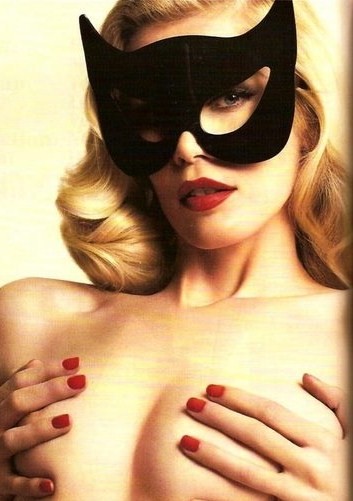
Honey, I'm home. Oh, I forgot. I'm not married.
Dogs supposedly give away their one life to live to owners like we hand out tissues, wheras cats always have another eight to fall back on. That being said, I'd rather be a cat than dog. Miau.
Photo: Mario Testino
Raoul

Raoul Dufy- Les Pêcheurs à l'ombrelle rouge devant Sainte-Adresse (1907)
Looking through French Fauvist painter Dufy's work is time well-spent and easily consumed. His sense of colour palettes is really something else at times. It's a pity; some of his fine work seem not to be particularly accessed on the World Wide Web.
Rupam

And who am I? That's one secret I'll never tell, you know you love me, xoxo, Goss...Oh fuck that, you know who I am (and while at it, fuck also the show I just shamelessly paraphrased) and If you happen not to know then that's really perfectly fine as well. No need. Although unlikely to start embodying all the characteristics of Martin Margiela starting now, I also do not intend to bore the other by disclosing my progress in bench pressing or the number of coffees I've had during the day that just passed or post pictures of the cute dog I don't own. Ah, you seem to have gotten the point already? OK then, full stop right about...here.
Jon

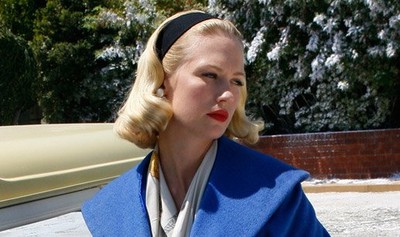
The blatant quality of a show like Mad Men makes going into words about it feel particularly redudant. So much to say and much of it has been said already. So what does make the cut? Subtleness. One of the aspects mastered by creator Matthew Weiner (formerly known as a writer for the Sopranos) is the subtleness of the show which is where a great deal of its strength lies. As frustrating as it may be at times, it's refreshing with no rushing whatsoever in terms of letting the drama play out as slowly as it does. One will be getting the feeling nothing much ever happens and yet it does. The use of silence in the ending scenes of episodes has an impact insofar that the storylines sometimes stays with the viewer long after the end. Every now and then the show brings thoughts to Wong Kar Wai's chef-d'oeuvre In the Mood For Love and that should say a lot.
Mr Dapper himself; Don Draper, as played meticulously by Jon Hamm, is by far the most charming and interesting protagonist on television since Agent Dale Cooper of David Lynch' Twin Peaks. With his Cary Grant and Clark Gable-ish sort of looks from an other era in time, one wonders where the world has had this guy in hiding for so long? Most certainly Hamm has fair potential of crossing over, doing a Clooney. Not mentioning January Jones' (Such lovely name it is too, does it not sound like the name of a Bond girl?) playing Mrs Don Draper (Betty), the repressed surburbian housewife would be an utter sin as she displays talent easily matching Hamm's. Her looking like a dead ringer for Grace Kelly just proves the effort that has been put down at the casting office as well as at other department's of the show in order to give the show it's authentic 60's feel. Detailing is everything and Mad Men just never seems to fail there.
Alain
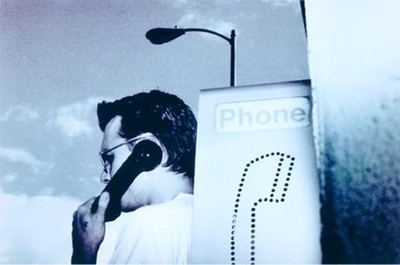
"Does beauty give birth to love or does love give birth to beauty? Did I love Chloe because she was beautiful or was she beautiful because I loved her? Surrounded by an infinite number of people, we may ask why our desire has chosen to settle on this particular face, this particular mouth or nose or ear, why this curve of the neck or dimple in the cheek has come to answer so precisely to our criterion of perfection? Every one of our lovers offers different solutions to the problem of beauty, and yet succeds in redefining our notions of attractiveness in a way that is as original and as idiosyncratic as the landscape of their face."
-Essays in Love
Photo: Anton Corbijn (from 33 Still Lives)
David

David Hockney
It's interesting. This painting by Hockney makes me strongly think about The Swimmer (1968), a modest classic starring Burt Lancaster which was based on a likewise titled short story by John Cheever, published in The New Yorker way back when, which some fourty years later served as inspiration for an editorial shoot helmed by photographer Steven Klein, ultimately proving that art imitates art.
Jean-Claude

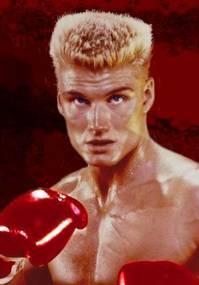
Remember us?
In a press release the other year Dolph Lundgren confided; "You know, I was thinking today, it would be great to make a movie with the '80s action Rat Pack -- Jean-Claude and a few others." Rat Pack? Rather bold usage of the term, I'd say, naturally thinking of Sammy Davis Jr, Frank Sinatra and Dean Martin. Treasured film critic Roger Ebert quipped: "I remember it more as the Rat Whack."
There are obviously action movies around but is the real action hero a dying breed? I can't think of many today, at least not of actors who are but who also lack the interest or ambitions of becoming more than just that. Anyone that comes to mind seems to be one by typecasting rather than by choice.
Cynthia
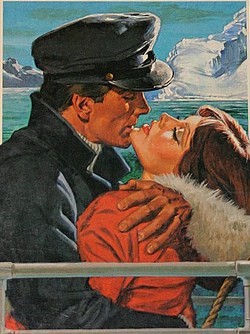
In her column Nice Girls Don't Read Romances, she examines the interesting question as to who actually reads romancing novels (or Harlequin romances as they're also known as due to publishing giant; Harlequin Entreprises Ltd). Come to think of it, who hasn't wondered when waiting in line to pay at the counter of the local grocery shop? There they are, next to the more mainstream titles off of the best seller's list, these novels with cheesy and sometimes ridiculous art work displaying the backside of a bulky male, passionately embracing his woman, with amusing titles which sound like they were scripted by the niftiest of kids in a poerty work shop at school (How about; Quiet Walks the Tiger, Liar's Moon, Tender Deception or Tempestous Eden?)
Heimel shares with readers her initial assumptions on who the targeted group is, before reading one herself: Trashy women. The women who are always wearing housedresses or polyester pantsuits when out and who will drool in the subway or at airports over doll-like women with raven black hair (they always have raven hair it seems), long legs, high breasts and tiny wastes getting ravished by the rugged hands of a brooding man. Heimel concludes by outing her own friends as readers of the romance novel and by confessing to getting it (read: the glory of the romancing novel) Could it be one of those do-but-not-talk-about-things?
Heimel offers her own discription of the genre as; "masturbation books" or "romance pornography" and consequently also includes the differences as she sees them between men's and women's pornography. In this so called "romance pornography" the women crave their men to be honourable, to have valor, social standanding and morality and there is also a focus on beautiful locations, wheras in men's pornography it will basically suffice if the women just have "tits" and "beg for it".
Apart from excerpts of this genre in question I'm denying any familiarity with it, but who knows what summer has in store?
Carla

What's amusing with France's First Lady is the feeling of having known of her for longer than most people have been able to count 'til 10. Although it feels like half a life-time ago, one remembers Bruni as a reigning model in the 90's in the age of the Valettas, rather than during the 80's rule of the Turlingtons and Evangelistas. In the 90's she would be equally known for her liasions with such royalties as Eric Clapton, Donald Trump and Mick Jagger. Whatwith the Internet being plastered with nude (yet tasteful and sometimes exquisite, in Bruni's defense) pictures of her some would likely toy with the idea of Bruni being yet another tart turned lady by age. Adding to the story, a character based on her was featured in her sister's (ultra-talented director/actress Valeria Bruni-Tedeschi, most notably known for her fine performances in Francois Ozon's 5x2 and Time to leave) autobiographical directorial debut, It's Easier for a Camel, about their upbringing in a wealthy priviliged Italian family. Not too pleasing for Carla, she was potrayed as a difficult bitch.
Now the former president of the U.S, George W. Bush, was quoted telling Sarkozy in a press conference on his visit to France; "It was a great pleasure to have been able to meet your wife. She's a really smart, capable woman, and I can see why you married her." In the public eye she may be Mrs Sarkozy from now on but Bruni is no stranger to talent of her own. Having studied the piano, violin, and guitar while growing up, Bruni surprised both the public and the critics with whom she gained plenty of acclaim when releasing her debut album, Quelqu'un m'a dit, in 2002. Produced and written entirely by Bruni herself, the album is absolutely enchanting with its low key chansons and sometimes perfect lyrics, coming across as effortless.
La dernière minute
Quand j'aurai tout compris, tout vécu d'ici-bas
Quand je serai si vieille, que je ne voudrai plus de moi,
Quand la peau de ma vie sera creusée de routes,
Et de traces et de peines, et de rires et de doutes,
Alors je demanderai juste encore une minute...
Quand il n'y aura plus rien qui chavire et qui blesse,
Et quand meme les chagrins auront l'air d'une caresse,
Quand je verrai ma mort juste au pied de mon lit,
Que je la verrai sourire de ma si petite vie,
Je lui dirai "écoute ! Laisse-moi juste une minute...
Juste encore minute, juste encore minute,
Pour me faire une beauté ou pour une cigarette
Juste encore minute, juste encore minute,
Pour un dernier frisson, ou pour un dernier geste,
Juste encore minute, juste encore minute,
Pour ranger les souvenirs avant le grand hiver,
Juste encore une minute... sans motif et sans but.
Donald

I'll tell you everything i know
any little thing i know
i'll tell you everything i know
any little things i know
you've got a lovely way with words
must be the way you see the world
it's just the way you see the world
...
I went down to your house last weekend
you said, "come on man, you don't have to point out
everything that's bad.
so there's a broken mirror on my bed
I'll clean it up,so what?
you don't have to be such an asshole all the time."
Aww don't be like that.
The Virgins- Rich girls.
(above) Donald Cumming, the singer of The Virgins, as photographed by Ryan McGinley (below).
Ingrid

Chopin Prelude op 28 nr 2
-Käraste lilla Ewa...
-Är det allt du kan säga?
- Nej, jag blev bara så rörd.
-Tyckte du om det?
- Jag tyckte om Dig.
-Jag förstår inte vad du menar...
-Kan du inte spela någonting annat nu när vi har det så skönt?
-Jag vill veta vad jag gjorde för fel.
-Nej, du gjorde inget fel.
-Du tyckte tydligen inte om mitt sätt att spela det här preludiet?
-Men var och en måste ju ha sin uppfattning...
-Ja juste, nu vill jag veta din.
-Men du är ju ond redan...
-Nej, jag är ledsen för att du tydligen inte tycker att det är mödan värt att berätta hur du själv ser på det här preludiet.
-Nåja,om du absolut vill. Vi bortser från det rent tekniska som inte var så tokigt, trots att du gott kunde ha intresserat dig en smula mer för Cortos fingersättningar eftersom det ger en viss hjälp för tolkningen men för all del, nu ska vi bara tala om uppfattningen...Chopin var känslostark, inte känslosam, det är en avgrund mellan känsla och sentimentalitet. Preludiet du spelar talar om återhållen smärta utan drömmerier. Du måste vara lugn, klar och kärv. Se bara första takterna... Sen en kort lindring men den förflyktigas nästan genast och sen är plågan densamma. Inte större, inte mindre. Behärskningen är hela tiden total. Chopin var stolt, sarkastisk, hetsig, plågad,Ewa...och mycket manlig, inte en känslomässig kärring.
Det här andra preludiet måste nästan spelas fult, får aldrig bli insmickrande, det ska låta fel. Mödosamt eller framgångsrikt genomkämpat.
-Jag förstår.
-Bli inte ledsen på mig Ewa.
-Varför skulle jag bli ledsen? Tvärtom.
När jag var barn beundrade jag dig varnsinnigt. Så var jag trött på dig och dina pianon i många år men nu har jag börjat beundra dig igen. Fast på ett annat sätt.
-Då finns det ju hopp!
-För all del.
From Ingmar Bergman's Autumn Sonata.
Nan

Nan Goldin- The Ballad of sexual dependency
The light, the colours, the cigarette, the positions on the bed and the overall feel of this frame.
Hands down last year's best exhibition in Stockholm, at Kulturhuset.
Bette

Star wars
If there was ever a rivalry and feud that outshone the rest, the one between legendary actresses Bette Davis and Joan Crawford was likely it. What originally fuelled the falling out of the two was actor Franchot Tone who was the object of affection of both, who Davis fell in love with but Crawford married in the mid 30's. From thereon bad blood is said to have remained between them until the death of Crawford in 1977. Although numerous memorable remarks were made about the other by both during their neverending sparring (Davis about Crawford: "She slept with every male star in MGM except for Lassie." Crawford on Davis: "Working with Bette Davis was my greatest challenge and I mean that kindly. She liked to scream and yell. I just sit and knit. During the filming of What ever happened to Baby Jane?, I knitted a scarf from Hollywood to Malibu...") the one made by Davis upon learning about Crawford's death may be the one revealing to what extent there was animosity between them. Davis simply said: " You should never say bad things about the dead, only say good. Joan Crawford is dead. Good."
Joan Crawford saw her finest hour with her performance in 1945's Mildred Pierce with which her popularity reached its peak and also earned her her only Academy Award (The role was previously offered to Davis who passed.) Although considered a screen legend, Mildred Pierce is the only piece in Crawford's body of work that qualified as a true classic. Never as glamorous as her rival, Davis made a name for herself by bold choices and originally taking on roles other actresses would not take on, relying more on her talent than looks. Davis was outspoken and had the image of a tough lady who refused to comply with the standards of the industry. By the late 40's and early 50's the careers of both actresses were on the decline. However, Bette Davis had a short but very significant resurrection when landing the role of a lifetime as Margo Channing in the classic All About Eve from 1955. Her performance in it is widely held as one of the all-time best performances by a female actress. In the heydays of Davis and Crawford, studio executives would be trying to pair the two actresses two headline a film, however, without any luck due to disagreements. In 1962 Davis and Crawford set their differences aside to finally co-star in Whatever happened to Baby Jane?, hoping to revisit their past glory. By this time a project involving the two aged dames was hardly a guarantee for financial success and the head of Warner Bros, Jack. L Warner, was originally quoted saying that he wouldn't want to spend a nickel on either one of those two "old broads".
Joan Crawford had previously done advertisements for Pepsi and was also affliated to the brand by having been married to the former CEO, why Bette Davis had a Coca Cola-machine installed on the set of the film. Returning the favour, Crawford forbid her twin daughters to interact with Davis' daughter. The last great installment of the feud came when Davis was nominated for an Academy Award for her part in the film, desperately wanting to win her third Oscar which would have set a new record for numbers of Oscars won by an actress (The record was later held by Katherine Hepburn).Crawford is believed to have actively campaigned against Davis' potential win and even accepted the Oscar that night on the behalf of winning actress Anne Bancroft who was absent from the show. Davis being Davis never forgave Crawford for her stunt.
Towards the end of their lives both Crawford and Davis experienced their share of personal tragedy. During a time when unauthorized kiss-and-tell stories had yet to hit the book shelves, Crawford's daughter shocked the film industry by writing a biography (Mommy dearest) about her alcoholic mother, including stories of child abuse and neglectance. Later Davis' daughter BD Hyman, who the former referred to as "the love of my life", wrote a similar book at a time during which her mother was battling cancer. BD Hyman likely seized the opportunity to capitalize on the success and fame of Crawford's daughter, thinking Davis wouldn't likely survive her illness anyway. Neither actress ever reunited with their daughter.
Marina
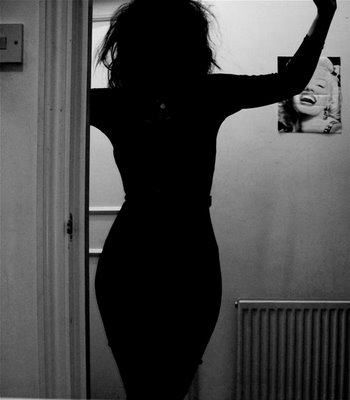
Sunday, wake up, give me a cigarette.
Last night's love affair is looking vulnerable in my bed
Silk sheet, blue dawn, Colgate, tongue warm
Won't you quit your crying? I can't sleep
One minute I'm a little sweetheart
And next minute you are an absolute creep
We've got obsessions
I want to wipe out all the sad ideas that come to me when I am holding you
We've got obsessions
All you ever think about are sick ideas involving me, involving you
We've got obsessions
I want to erase every nasty thought that bugs me every day of every week
We've got obsessions
You never tell me what it is that makes you strong and what it is that makes you weak.
Marina & the Diamonds- Obsessions.
Bret

Although I have yet too see it, that is if it ever sees daylight around these shores whatwith its obvious off-beat feel and consequently limited appeal to the masses (given Ellis' bankable name, it doesn't come across as implausible that it will), I'd think Gregor Jordan probably should've taken some cues from Mary Harron when signing up. The latter's grip on the directing and execution of American Pschyo was absolutely sensational I've come to learn having seen it a few times since its release in 2000 and it is by far the only truly good adaptation of Ellis' work yet. Let's not go into words about the mess that was the adaptation of Less than zero...
On another note, what is exciting is Ellis' bringing back Clay, the anti-hero of Less than Zero and the others back for another round in the already mentioned Imperial Bedrooms, some twenty years later and now in their middleage. Surely little has changed with (at least some of) these indifferent and laissez-faire characters still on a downward spiral to destruction, as started in the first novel. Randomly picking Less than Zero up at the bookshop 8 years ago, simply judging from the highly pleasing art work and loosely knowing about this creator of Patrick Bateman, surely qualifies as one of the best buys in the history of this household.
Photo: Guy Bourdin
